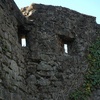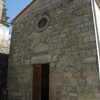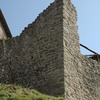Castle of Perpoli
The castle of Perpoli is located on top of a rocky outcrop located between the river of the Canale Grande and the Serchio river. From this location, it was possible to keep an eye on other communities in the Valle del Serchio and the Garfagnana, including Riana, Treppignana, Castelvecchio, La Barca and Cascio.
The village still conserves its ring-shaped which used to contain the old fort, parts of which are still visible on the northwestern edge of the rise. The stretch of wall, which is preserved to a height of about two metres, follows the course of the hill and was originally in an elliptical form. Given the type of construction technique and the absence of additional elements, such as windbreak turrets or others, the structure can be generally attributed to the XII-XIII century.
The construction of additional walls, placed lower down, date to a later period and were heavily damaged by the earthquake that shook the Garfagnana in 1920 and the bombings which took place during the Second World War.
Ony two of the original gates still exist, while a third has undergone major reworking. Another element of defence which is still visible is a kind of bulwark which lies near the southern slope.
Historical notes
Belonging since the tenth century to the coterie of Corvaresi, the castle of Perpoli was one of the strongholds of the resistance for the nobles of Versilia opposed to the expansionism of the City of Lucca. In 1170, the castle finally surrendered to the siege of the armed municipalities.
It became one of the bases from which Lucca, with the repeated military incursions of the twelfth and thirteenth centuries, managed to tame and subdue the noble factions of the Garfagnana. Precisely because of its central location, in the thirteenth century it became the limit established by the Elders of Lucca to distinguish two large territorial compartments; the closest to the city was listed as Vicariate "a Perpore infra" and the rest of the mountain as Vicariate “a Perpore ultra".
Castruccio Castracani also held this fortification in high regard and it was the will of the Imperial vicar that a bridge was erected over the Serchio to join Perpoli and Riana.
Mentioned in the Golden Bull in 1376 as "Castrum Perpoli" the military construction appears under the definition of "Fortessa" also in the list of the fortifications that Paolo Guinigi, in the early fifteenth century, decreed should always be kept well supplied with weapons and, where there was a need, restored.
After the fall of the lordship of Lucca, the community and the castle of Perpoli suffered considerable damage, so much so that many structures were destroyed. New reconstructions and renovations to the "fortress" were built in the sixteenth and seventeenth centuries during the wars that saw the militias of Lucca and Este opposed. In particular, in 1583 the village was set on fire in retaliation by armed Este forces, while in 1613 the town was again fortified and connected to the small redoubt on Monte Perpoli.











